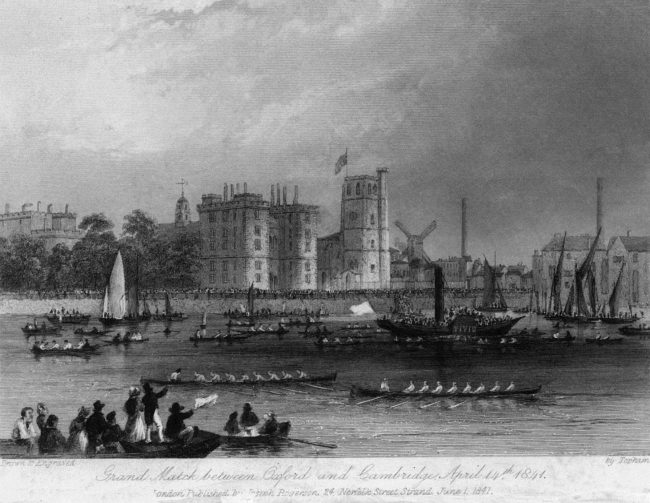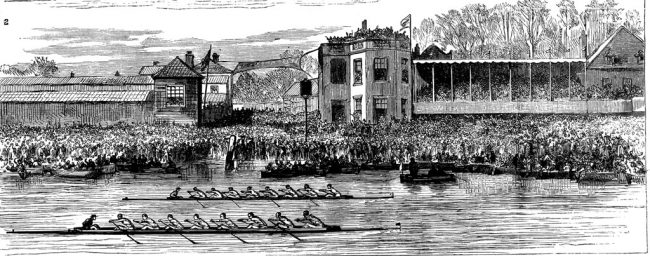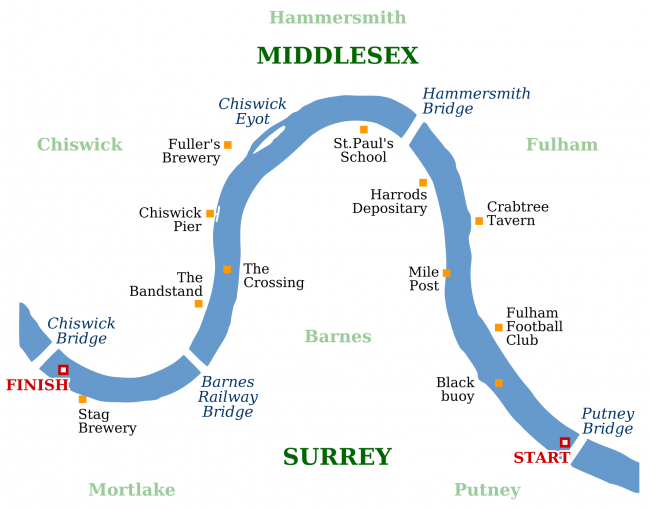
The 1841 Oxford-Cambridge Boat Race – engraving – 1841. “Grand Match between Oxford and Cambridge, April 14th 1841
On June 10th 1829 the very first of now legendary annual boat races of Oxford and Cambridge on the river Thames took place. The race came about because two friends from Harrow School, Charles Wordsworth (nephew of the poet William Wordsworth and later bishop of St Andrews), of Christ Church College, Oxford, and Charles Merrivale of St. John’s, Cambridge, met during the vacation in Cambridge, where Wordsworth’s father was master of Trinity.[1] Wordsworth went rowing on the river Cam, and the two school fellows decided to set up a challenge.
Cambridge Challenged Oxford…
Cambridge challenged Oxford to a race at Henley-on-Thames stating ‘that the University of Cambridge hereby challenge the University of Oxford to row a match at or near London, each in an eight-oared boat during the ensuing Easter vacation.’ In the end, Oxford won this first race easily. The second race occurred in 1836, with the venue moved to be from Westminster to Putney. Over the next couple of years, there was disagreement over where the race should be held, with Oxford preferring Henley and Cambridge preferring London. 1856 was the first in what was to become an uninterrupted series of annual races, save the gaps during the two world wars.

A portrayal of the dead heat finish in 1877.
Safety Issues
The races not always run safely.In the 1912 race, run in extremely poor weather and high winds, both crews sank. Oxford rowed into a significant early lead, but began taking on water, and made for the bank shortly after passing Hammersmith Bridge to empty the boat out: although they attempted to restart, the race was abandoned at this point because Cambridge had also sunk, while passing the Harrods Depository. Cambridge also sank in 1859 and 1978, while Oxford did so in 1925, and again in 1951. In 1984 the Cambridge boat sank after colliding with a barge before the start of the race.

Course of Boat Race,
Dark Blue vs Light Blue
Oxford’s team is often referred to as the dark blues, while the Cambridge team is also known as the light blues. These colours are also reflected in the rowing jerseys of both teams. The route leads from Putney upstream to Mortlake; it is 4 miles and 374 yards (6779 m) long. Start and finish points are marked by the University Boat Race Stones on the right bank of the river. The start is 129 m upstream of Putney Bridge, the finish 112 m downstream of Chiswick Bridge. A well-known landmark is Chiswick Eyot. In this section, the Thames is still influenced by the tides of the North Sea. The start takes place during the tide, so that the boats sail with the current; accordingly it is tried to sail in the current. The start takes place during the tide, so that the boats drive with the current; accordingly it is tried to drive in the current line.

The Cambridge Team of 1890, La Revue des sports, 2 avril 1890, p.1027
The Women’s Boat Race
But, it is not only a men’s world! The Women’s Boat Race has been installed in 1927 as an annual rowing race between Cambridge University Women’s Boat Club and Oxford University Women’s Boat Club. First rowed in 1927, the race has taken place annually since 1964. Since the 2015 race it has been rowed on the same day and course as the men’s Boat Race on the River Thames.

The Oxford Winning Team of 1890, La Revue des Sports (Paris), 29 mars 1890, p.1019
My Oxford Diaries – Episode 2: Oxford University Boat Races, [7]
References and Further Reading:
- [1] William Wordsworth and the Romantic Age of English Literature, SciHi Blog
- [2] The Boat Race, official website
- [3] 1927 race footage British Pathé
- [4] The story of the women’s race BBC Sport video
- [5] The Boat Race at Wikidata
- [6] Oxford win historic second race of 1849
- [7] My Oxford Diaries – Episode 2: Oxford University Boat Races, Helen Kosc @ youtube
- [8] The Boat Race course visualization on Google Earth/Maps (in Italian)





